Kaldheim Storytime, Part 2
Last week, I started telling card-by-card design stories from Kaldheim. I have more stories to tell, so that means we get a part two. That said, on with the stories.
Toralf, God of Fury // Toralf's Hammer
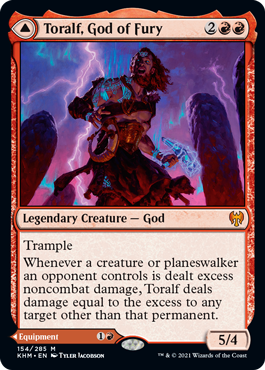
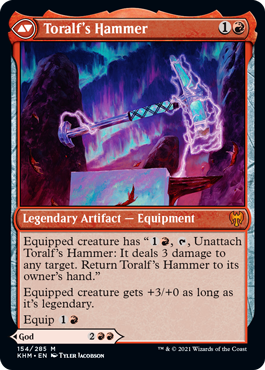
As I explained when I previewed this card, when we first came up with the idea of doing all the Gods as MDFCs, the very first idea we had—in fact, the idea that prompted us to make the Gods MDFCs in the first place—was Thor and his hammer. Interestingly, when I went back to look at the very first design, it was not at all what I remembered.
Auki the Braggart
2GG
Legendary Creature — God
4/4
Play with your hand revealed. Whenever you draw a nonland card, put a +1/+1 counter on CARDNAME. Whenever a creature dealt damage by CARDNAME this turn dies, draw a card.
Auki's Hammer
2G
Legendary Artifact — Equipment
Equipped creature gets +2/+2 and had "1G, T: This creature deals damage equal to its power to target creature or player. Unattach CARDNAME."
Equip legendary creature 2
For starters, it was green? Thor in Norse mythology is a pretty red character. (The Marvel version of Thor is more red-white.) My best guess is that we just made a cool Thor and Mjölnir (Thor's hammer), and they just got stuck in the color that best matched the mechanical flavor. You can see from the very beginning that the two cards were designed to play well together. We wanted to make sure that if you got the hammer out, there was clearly one creature who would most benefit from it. Also, you can see that we wanted the hammer to be something that got "thrown." Finally, note that the card could only equip to legendary creatures. This was our nod to the fact that only the worthy can lift Mjölnir.
The card was changed pretty quickly because I'm sure people like me said, "Thor's has to be red." Here was the original red version:
Auki the Thunderer
2RR
Legendary Creature — God
4/4
Play with your hand revealed. Whenever you draw a nonland card, CARDNAME deals 3 damage to any target.
Auki's Hammer
2R
Legendary Artifact — Equipment
Whenever an effect you control deals noncombat damage, put a +1/+1 counter on equipped creature.
Equip legendary creature 2
The three damage in this version was us making a nod to Thor being the god of lightning (as Lightning Bolt is an iconic direct-damage spell that deals 3 damage to any target). While much changed, we still tried to make sure that our version of Thor was the best with his hammer.
Here's the next iteration:
Toralf the Thunderer
3RR
Legendary Creature — God
4/4
CARDNAME and other Gods you control have haste.
1R, discard a card: Deal 3 damage to any target.
Rikrammr
1R
Legendary Artifact
Equipped creature has "T, Unattach CARDNAME: CARDNAME deals 3 damage to any target. Return CARDNAME to its owner's hand."
Equip legendary creature 1
Equip 4
The next version had Toralf granting the other Gods haste to show a sense of leadership in battle. His lightning bolt got changed from a draw trigger to an activated ability with a discard. His hammer got a proper name and a mechanic that not only allowed you to throw the hammer but also have it return. Having it return to the creature that threw it didn't really do anything, so we had it return to its owner. That let us power it up a bit. Also, returning it to your hand allowed you to play the hammer early and then play the card as Toralf later. We were far from done, though:
Toralf the Thunderer
3RR
Legendary Creature — God
4/4
Whenever one or more legendary creatures attack for the first time each turn, untap all legendary creatures you control. After this phase, there is an additional combat phase.
Toralf's Hammer
1R
Legendary Artifact
Equipped legendary creatures you control get +3/+0.
Equipped creature has "1R, T, Unattach CARDNAME: It deals 3 damage to any target. Return CARDNAME to its owner's hand." Equip {o2}
Equip 4
We then tried a version that was basically a walking Relentless Assault to play into Toralf leading other Gods and heroes into battle. I think the idea was that the hammer was conveying the flavor of creating lightning. This version of the hammer got rid of the equipping of legendary creatures and instead gave them a +3/+0 bonus. Note that this version not only enhances the creature it equips but any equipped legendary creatures, too. The Creative team also decided to call it Toralf's Hammer rather than by a proper name.
Next up:
Toralf the Thunderer
3RR
Legendary Creature — God
5/3
Haste
Whenever a source you control deals excess damage, it deals that much damage to another target.
Toralf's Hammer
1R
Legendary Artifact
Equipped creature gets +3/+0 if it's legendary and has "1R,T: Unattach CARDNAME: It deals 3 damage to any target. Return CARDNAME to its owner's hand."
Equip 2
This change gets Toralf closer to his final version. The printed card changes his stats from 5/3 to 5/4, haste to trample, and more carefully defines the conditions under which extra damage gets triggered. The hammer now only grants the +3/+0 to the creature it equips. The printed version changes the equip cost from 2 to 1R and changed how the card is templated, but it's pretty close to this version.
I'm very happy with how this card ended up, but you can see it went through a lot of changes.
Toski, Bearer of Secrets
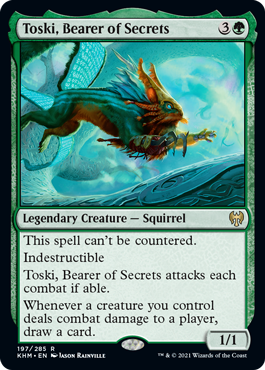
Longtime readers know that I am a huge fan of Squirrels. (For example, here's an article I wrote back in 2002 during Squirrel Week.) I have probably been the top Squirrel advocate from the day I started working at Wizards but was also the cause of their banishment from black border. You see, ever since I started working on sets, I was always looking for opportunities to put Squirrels on cards. For Odyssey, I was put in charge of the creative text of the set, which meant I oversaw names, flavor text, and creature types. (This was back in the day when creature types tended to impact card concepting more so than today. Nowadays, unless it's mechanically relevant that a creature is a certain creature type, design doesn't dictate what it is.)
The end result was that Odyssey block had a lot of Squirrels in it. I even made the base 1/1 green creature token type Squirrels. This was on top of a few high-profile Squirrel cards I'd made in Urza's Saga block (Deranged Hermit probably being the most famous). It resulted in a number of high-profile tournaments (including the US National Championship where Aaron Forsythe made the American team with a deck built with Deranged Hermit as its MVP). At the time, the Magic brand team wanted the Magic brand to be a little more hard-edged, and they hated that Squirrels were showing up on camera in major tournaments, so they decided no more Squirrels. That was when they got kicked out of black border.
I used silver border to keep the Squirrels alive in Magic, but there are only so many Un- sets. My goal for a long time was to try and get Squirrels back into black border. I found a great ally in Mark Purvis (one of Magic's current architects—what brand managers have evolved into) who shares my love of Squirrels. Little by little, we did what we could to revive Squirrels, bringing more and more R&D members into our mission. The first to return in black border was Helica Glider in Ikoria: Lair of Behemoths. I was happy to see it, but it wasn't green (or even black, Squirrel's secondary color). I knew Kaldheim had the potential for Squirrels to make a bolder return.
You see, in Norse mythology, there's creature named Ratatoskr, a squirrel that runs up and down the world tree carrying messages between a serpent at the bottom of the tree and an eagle at the top. What could put the stake in the ground that Squirrels have returned to black border more than the first-ever legendary squirrel (in black border; I did make Acornelia, Fashionable Filcher in silver border in Unsanctioned)? I didn't know exactly what Toski (our version of Ratatoskr) was going to do mechanically, but I was going to do everything to make sure he made it into the set. Interestingly, times have changed, and no one seemed interested in not having him in the set. He went in during early vision design and never left. Here's the first version:
Ratatoskr, Mischievous Squirrel
3G
Legendary Creature — Squirrel
1/1
Indestructible
CARDNAME must be blocked if able.
Whenever another creature you control deals combat damage to an opponent, draw a card.
As you can see, it wasn't too far from where he ended up. The next version added "CARDNAME attacks each turn if able." Then "another" got dropped so that Toski could draw you a card when he dealt combat damage to an opponent. Then "CARDNAME must be blocked if able" got removed. Finally, "can't be countered" got added.
One last thing: there's been some discussion if this card, mechanically not creatively, is green. Well, let's examine.
This spell cannot be countered – This ability is primary in green, especially on creatures.
Indestructible – This ability is primary in white, but secondary in black and green.
Toski attacks each turn if able – This ability is primary in red. Of all the abilities, this one is the biggest bend, but even then, green is the color of natural animals and has a lot of combat-oriented abilities, so it's not that big of a bend. It's also a drawback. Bleeding drawbacks is usually not that big of a deal.
Whenever a creature you control deals combat damage to a player, draw card – This is granting an ability that R&D calls "curiosity" (a saboteur draw trigger). Curiosity is primary in blue and secondary in green. Usually, the primary color is more likely to grant the ability to other creatures, but the secondary has access to it.
All this means is that Toski's only bend is his drawback, and it's not even that big of a bend. Everything else is squarely in green's part of the color pie, so this is cleanly a green card.
And yes, please see Toski as a harbinger of Squirrels to come. (Note this doesn't necessarily mean a horde of Squirrels, just that Squirrels have been allowed back into black border and will show up on occasion.)
Valki, God of Lies // Tibalt Cosmic Imposter
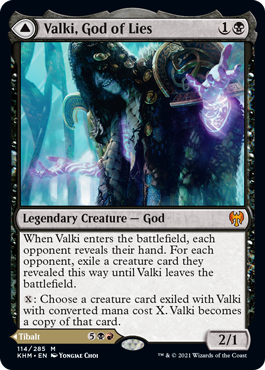
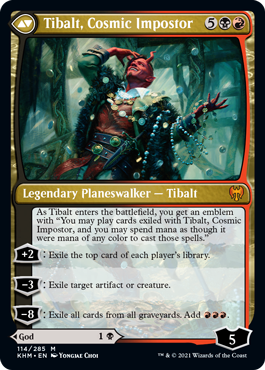
When I originally divvied up the MDFCs between Zendikar Rising, Kaldheim, and Strixhaven, I said that Kaldheim would have MDFCs that all had a creature on one side and a permanent on the other. When we decided to make Gods the MDFCs, it seemed clear that we wanted a God on one side and then various permanents on the other. For variety's sake, we decided to see how many different things we could have on the back. We could have a creature. We could have an artifact. We thought an Equipment and a Vehicle would feel different from one another. We could have an enchantment. We couldn't have a land, as that was Zendikar Rising's schtick. But wait, there was one more permanent type. What about a planeswalker?
At first, we laughed about it, but then we started thinking. Could we do a planeswalker? What would make sense? And then we got a crazy idea. What if our version of Loki was a planeswalker pretending to be a God? Loki has many stories about how he disguises himself as others. It would be a fun twist to reverse that. And who should the planeswalker be? It didn't take long to realize there was one choice above all the rest—Tibalt! Tibalt's first card is probably the lowest powered planeswalker we've ever made, and it helped Tibalt become a Magic meme. This endeared him to a number of players and "more Tibalt" became a pretty common request. Yes, he was in War of the Spark, but then again, who wasn't? This was a chance to let him have the spotlight in a cool way.
From this idea, we designed a card that was a mono-blue legendary God on the front and a black-red Tibalt on the back. (While Tibalt has only appeared as a mono-red planeswalker, the character is actually black-red.) Here's our first design:
Tibalto, God of Wisdom
1U
Legendary Creature — God
1/3
1, Sacrifice a creature: Draw a card.
1, Discard a card: Draw a card.
Tibalt
4BR
Legendary Planeswalker — Tibalt
Loyalty - 5
+2: Deal 1 damage to target player. That player draws a card.
-3: Deal damage to any target equal to the number of cards in your hand.
-6: Target opponent creates an emblem with "Damage dealt to you is tripled."
The front side of this card is a very Melvin design. It's pretending to be a mono-blue god of wisdom. Both of its abilities draw cards, a very blue thing to do, but each of them is actually doing it in a way that another color would do it. Sacrificing a creature for a card is black, and discarding a card is red (it's basically rummaging). On the surface, the card looks to be a blue card, but when you dig deeper, you see it's actually black-red. This card is what Vision Design handed off, except the activations were changed from 1 to B and R, respectively.
The design for Tibalt played into the card drawing of the front side. The +2 ability is either a red ability with a drawback if you target the opponent or a black draw card if you target yourself. The -3 ability is a direct-damage spell that cares about cards in hand. The -6 ability is an ultimate the ties into the direct damage of the first two abilities.
The card went through a number of changes during set design. (It's pretty normal for planeswalkers to get completely redesigned.) Here's an early version of Set Design's take on the character.
Valki, God of Lies
1B
Legendary Creature — God
1/3
When CARDNAME enters the battlefield, target opponent reveals their hand. You choose a creature card from it. Exile that card until CARDNAME leaves the battlefield.
X: CARDNAME becomes a copy of target creature card with converted mana cost X exiled by it, except its name is CARDNAME and it's legendary in addition to its other types.
Tibalt
3BR
Legendary Planeswalker — Tibalt
Loyalty – 5
+1: Target opponent may have CARDNAME deal 4 damage. If they don't, draw two cards.
–2: Each player's life total becomes 13.
-6: Target opponent gets an emblem with "If a source would deal damage to you, it deals triple that damage to you instead."
First up, they changed the front to black and made it the Loki analogue. Tibalt was disguising himself as the god of lies. The new design played more like a top-down Loki. It steals a creature from the opponent and then can disguise itself as that creature. The Tibalt was much closer to the original design.
The published design mostly just tweaked Valki; he now takes a card from each opponent. Tibalt, though, went through a redesign. His static ability ties in with Valki by letting you cast the cards that have been stolen. The other two abilities were in colorways to exile cards (black can mill and destroy creatures; red can destroy artifacts) to play with the static ability.
While the original will always hold a soft spot in my heart, as it's a very cute Melvin design, I'm happy with the final version.
The World Tree
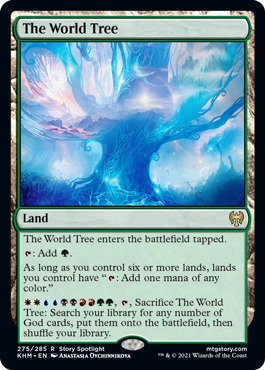
A frequent question I get on social media and my blog is "Why isn't this legendary? How many World Trees are there?" The short answer: legendary lands don't tend to lead to good gameplay. Here's why. Drawing a second legendary creature can be annoying, but it serves as a backup if your opponent kills the first one. Lands seldomly get destroyed, so once you play the first one, the rest tend to get stuck in your hand as dead cards. Now, if you're an experienced player, you take that into account when building your deck. You might play less than four or put in ways to sacrifice your lands for a benefit. At bare minimum, you build your deck not relying on the extra copies as a full land. Less experienced players don't see the problem and just treat legendary lands like they would any other land, which more often leads them to mana screwing themselves and having less fun.
We try to make cards as mechanically fun and creatively satisfying as we can, but when the two butt heads, we tend to err on the side of gameplay. To help with the creative issue, we worked into the creative years ago that lands don't technically represent specific places but rather mana bonds to that place. This means that for most locations, you can access multiple mana bonds, and it also explains why having two copies of The World Tree (or a deck full of Forests with the same art) is okay.
We have and will continue to print legendary lands from time to time when the card design makes sense, but it will be the exception rather than the rule.
"And They All Lived Happily Ever After"
That's all my stories for today. I hope you enjoyed hearing how the cards came to be. As always, I'm eager for any feedback, whether it be about this article, cards I talked about, or Kaldheim in general. You can email me or contact me through any of my social media accounts (Twitter, Tumblr, Instagram, and TikTok).
Join me next week when I answer your questions about Kaldheim.
Until then, may you enjoy your trek through the ten realms.
#803: Kaldheim, Part 2
#803: Kaldheim, Part 2
30:23
This is part two of a two-part series on the design of Kaldheim.
#804: Luis Scott-Vargas
#804: Luis Scott-Vargas
29:51
In this podcast, I interview Pro Tour Hall of Famer Luis Scott-Vargas who has worn many hats over the years.
- Episode 802 Kaldheim, Part 1
- Episode 801 Graham Stark
- Episode 800 Charlie Catino

